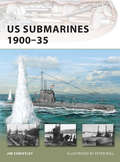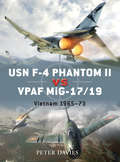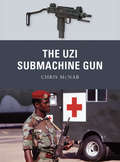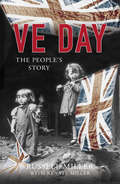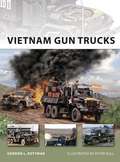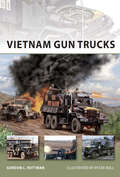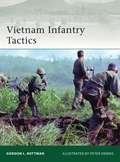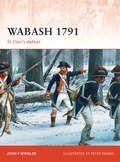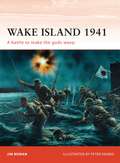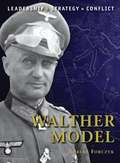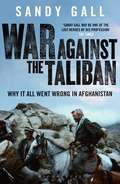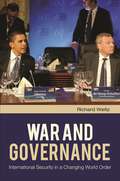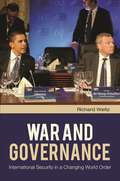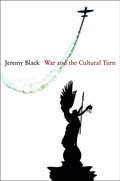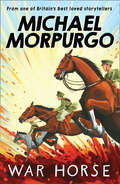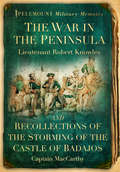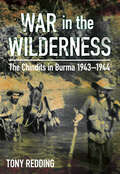- Table View
- List View
US Submarines 1900–35 (New Vanguard #175)
by Jim ChristleyThis book introduces the reader to the early years of US submarine development and operation during the first third of the 20th century. It was in this period of growth and change that the submarine moved from a small vessel of limited range and tactical strength to a far ranging force. It also covers the little-told story of the United State's submarine force during World War I, and the lessons they learned that would be passed on to future generations of submariners.
USN F-4 Phantom II vs VPAF MiG-17/19: Vietnam 1965–73 (Duel)
by Jim Laurier Gareth Hector Peter E. DaviesThe Vietnam War placed unexpected demands upon American military forces and equipment.The principal US naval fighter, the McDonnell F-4 Phantom, had originally been designed to defend the Fleet from air attack at long range. However, its tremendous power and bomb-carrying capacity made it an obvious candidate for the attack mission in Vietnam from 1965 onwards. Its opponent was the MiG-17, a direct descendant of the MiG-15, which had given USAF Sabre jets a hard fight in the Korean War. This book brings to life their dangerous duels and includes detailed cockpit views and other specially commissioned artwork to highlight the benefits and shortcomings of each plane type. It was in the skies over Vietnam that many of the techniques of air combat evolved as pilots learned how to use and to defeat supersonic fighters for the first time.
The Uzi Submachine Gun (Weapon #12)
by Chris McNabThe Uzi submachine gun is one of the most recognizable weapons in history. Its familiarity stems in part from the sheer diversity of its users. Uzis have been seen being wielded and fired by US Secret Service agents and SWAT teams, Israeli soldiers, European special-forces, as well as criminals and terrorists the world over. The reasons they use the Uzi are simple – it provides devastating close-range firepower in a reliable, highly compact weapon. Weapon: The Uzi Submachine Gun tells the story of this unique weapon. It not only explores the gun's technical development and specifications, but also describes the and analyzes Uzi's combat use in a wide range of contexts, from Israeli soldiers battling on the Golan Heights in 1967, through to modern pirates operating off the coast of Somalia. This book presents the facts and challenges the myths surrounding this remarkable weapon.
VE Day: The People's Story
by Russell MillerDrawing from first-hand interviews, diaries and memoirs of those involved in the VE Day celebrations in 1945, VE Day: The People’s Story paints an enthralling picture of a day that marked the end of the war in Europe and the beginning of a new era. VE Day affected millions of people in countless ways, and the voices in this book – from both Britain and abroad, from civilians and service men and women, from the famous and the not-so-famous – provide a valuable social picture of the times. Mixed with humour as well as tragedy, rejoicing as well as sadness, regrets of the past and hopes for the future, VE Day is an inspiring record of one of the great turning points in history.
Vickers Valiant Airplane (large print)
by RnibThis is an image of a jet bomber seen from above. There is a locator dot shown, which will be at the top left of the page when the image is the correct way up. The image is in the centre and a scale in metres on the left of the page. The aircraft nose is in the top centre and the tail in the bottom centre of the page. The fuselage goes up and down the middle of the page. The cockpit is shown as a small curved window near the nose. The wings go out to the left and right. Sticking out from the bottom end of the wing there are two jet engine nozzles to the left and right of the fuselage. The bottom edge of the wing has four flaps on each side and the tail wing has one flap on each side. These are the ailerons used to manoeuvre the aircraft when it is flying. In the middle of each wing sticking out to the front of the wing is a fuel tank which is attached underneath the wing.
Vickers Valiant Airplane (UEB contracted)
by RnibThis is an image of a jet bomber seen from above. There is a locator dot shown, which will be at the top left of the page when the image is the correct way up. The image is in the centre and a scale in metres on the left of the page. The aircraft nose is in the top centre and the tail in the bottom centre of the page. The fuselage goes up and down the middle of the page. The cockpit is shown as a small curved window near the nose. The wings go out to the left and right. Sticking out from the bottom end of the wing there are two jet engine nozzles to the left and right of the fuselage. The bottom edge of the wing has four flaps on each side and the tail wing has one flap on each side. These are the ailerons used to manoeuvre the aircraft when it is flying. In the middle of each wing sticking out to the front of the wing is a fuel tank which is attached underneath the wing.
Vickers Valiant Airplane (UEB uncontracted)
by RnibThis is an image of a jet bomber seen from above. There is a locator dot shown, which will be at the top left of the page when the image is the correct way up. The image is in the centre and a scale in metres on the left of the page. The aircraft nose is in the top centre and the tail in the bottom centre of the page. The fuselage goes up and down the middle of the page. The cockpit is shown as a small curved window near the nose. The wings go out to the left and right. Sticking out from the bottom end of the wing there are two jet engine nozzles to the left and right of the fuselage. The bottom edge of the wing has four flaps on each side and the tail wing has one flap on each side. These are the ailerons used to manoeuvre the aircraft when it is flying. In the middle of each wing sticking out to the front of the wing is a fuel tank which is attached underneath the wing.
Vietnam Gun Trucks (New Vanguard)
by Peter Bull Gordon L. RottmanWhile Vietnam is usually perceived as an infantry war, with US forces deploying by helicopter, the long supply lines that led to their inland bases had to be traveled by ground vehicles. The 8th and 48th Transportation Groups were responsible for hauling supplies through the long, dangerous roads of Vietnam, and they often found themselves the target of ambushes, attacks, and sniping. In response to this, vehicle crews began to arm trucks with machine guns and armour them with sandbags. While these proved less than ideal, the concept was considered valid, and more and more "gun trucks†? appeared, sporting heavier weapons and armor. Written by a Vietnam veteran, this book traces the development of these gun trucks from the jury-rigged originals to the powerful armoured vehicles that appeared later in the war.
Vietnam Gun Trucks (New Vanguard #184)
by Gordon L. RottmanWhile Vietnam is usually perceived as an infantry war, with US forces deploying by helicopter, the long supply lines that led to their inland bases had to be traveled by ground vehicles. The 8th and 48th Transportation Groups were responsible for hauling supplies through the long, dangerous roads of Vietnam, and they often found themselves the target of ambushes, attacks, and sniping. In response to this, vehicle crews began to arm trucks with machine guns and armour them with sandbags. While these proved less than ideal, the concept was considered valid, and more and more “gun trucks” appeared, sporting heavier weapons and armor. Written by a Vietnam veteran, this book traces the development of these gun trucks from the jury-rigged originals to the powerful armoured vehicles that appeared later in the war.
Vietnam Infantry Tactics (Elite)
by Peter Dennis Gordon L. RottmanThis book reveals the evolving US, Viet Cong and NVA tactics at battalion level and below throughout the Vietnam War. Beginning with a description of the terrain, climate and the unique nature of operations in this theatre of war, the author, a Vietnam veteran himself, goes on to explain how unit organisation was broken down by combatant forces and the impact this had on the kind of tactics they employed. In particular, the author highlights how units were organised in reality on the battlefield as opposed to their theoretical tables of organisation. US tactics included the standard US tactical doctrine as prescribed by several field manuals and in which leaders and troops were rigourously trained. But it also reveals how many American units developed innovative small unit tactics specifically tailored to the terrain and enemy practices. In contrast, this book also reveals the tactics employed by Viet Cong and NVA units including their own Offensive Operations, Reconnaissance, Movement Formations and Security, and Ambushes.
The Violets of March: A Novel
by Sarah JioThe island has a way of calling you home... Ten years ago, Emily Watson was on top of the world: a best-selling novel, a husband plucked from the pages of a magazine, and a one-way ticket to happily ever after.Now her perfect life has crumbled and Emily is left to pick up the pieces.So when her great-Aunt Bee invites her to spend the month of March on her beloved Bainbridge Island, Emily accepts, longing to be healed by the sea. As she begins researching her next book, Emily discovers a red velvet diary, dated 1943, whose contents reveal a startling secret that could change her life forever... A heart-breaking story of love, hope and second chances, from the international bestselling author of All the Flowers in Paris
Vulcan - Long-range Medium Bomber (large print)
by RnibThis is an image of a jet bomber seen from above. There is a locator dot shown, which will be at the top left of the page when the image is the correct way up. The image is in the centre and a scale in metres on the left of the page. The aircraft nose is in the top centre and the tail in the bottom centre of the page. The fuselage goes up and down the middle of the page. The cockpit is shown as a tiny window near the nose. The wings sweep down to the left and right and are widest at the tail end. Sticking out from the end of the aircraft there are two jet engine nozzles to the left and right of the tail. The bottom edge of the wing has four flaps on each side, these are the ailerons used to manoeuvre the aircraft when it is flying.
Vulcan - Long-range Medium Bomber (UEB contracted)
by RnibThis is an image of a jet bomber seen from above. There is a locator dot shown, which will be at the top left of the page when the image is the correct way up. The image is in the centre and a scale in metres on the left of the page. The aircraft nose is in the top centre and the tail in the bottom centre of the page. The fuselage goes up and down the middle of the page. The cockpit is shown as a tiny window near the nose. The wings sweep down to the left and right and are widest at the tail end. Sticking out from the end of the aircraft there are two jet engine nozzles to the left and right of the tail. The bottom edge of the wing has four flaps on each side, these are the ailerons used to manoeuvre the aircraft when it is flying.
Vulcan - Long-range Medium Bomber (UEB uncontracted)
by RnibThis is an image of a jet bomber seen from above. There is a locator dot shown, which will be at the top left of the page when the image is the correct way up. The image is in the centre and a scale in metres on the left of the page. The aircraft nose is in the top centre and the tail in the bottom centre of the page. The fuselage goes up and down the middle of the page. The cockpit is shown as a tiny window near the nose. The wings sweep down to the left and right and are widest at the tail end. Sticking out from the end of the aircraft there are two jet engine nozzles to the left and right of the tail. The bottom edge of the wing has four flaps on each side, these are the ailerons used to manoeuvre the aircraft when it is flying.
Wabash 1791: St Clair’s defeat (Campaign #240)
by John F. WinklerThe battle of Wabash, or St. Clair's Massacre, was the greatest defeat of the American Army by Native American forces. The campaign opened in 1791, when an newly formed American Army, under the command of Revolutionary War hero, Arthur St. Clair, set off into the wilderness of Ohio in an effort to wrest control of the Northwest Territory from the various native tribes. Plagued by logistical problems, bad weather, and native ambushes, the expedition dragged on for months as the American army slowly eroded due to injury, sickness, and desertion. Then, on a cold November day, an allied Native army descended on the Americans. In the ensuing chaos, the Americans were slaughtered, taking over 90% casualties. In this book, author John F. Winkler, re-examines this one-sided victory, analyzing what the American's did wrong and how the Natives achieved a victory that they could never repeat.
Wake Island 1941: A battle to make the gods weep (Campaign #144)
by Peter Dennis Jim MoranOn the same day that the Japanese attacked Pearl Harbor, they also launched air attacks on Wake Island, an American marine and naval base in the Pacific. Three days later a Japanese invasion force stormed the island, but were bloodily repulsed by the scratch force of marines, sailors and even service personnel who defended it. Despite US attempts to relieve the island, the Japanese launched a much greater invasion a few weeks later and, despite gallant resistance, eventually caused the US Forces to surrender. This book tells the complete story of the vicious fighting on Wake Island, one of the near-legendary 'last stands' made by US military forces.
Walther Model: Leadership, Strategy, Conflict (Command #15)
by Robert Forczyk Adam HookThis volume details the military career and accomplishments of Walther Model, the youngest Generalfeldmarschall in the Wehrmacht in World War II and Hitler's favourite commander. Model was a tough and tenacious commander, particularly when on the defensive, and his career rise was virtually unprecedented in German military history. Model really made his mark late in the war, when time was already running out for the Third Reich, but time and again he was rushed from one crumbling front to the next and succeeded in temporarily restoring the situation. Above all, Model deserves recognition as one of the great defensive commanders of modern military history.
War Against the Taliban: Why It All Went Wrong in Afghanistan
by Sandy GallAfghanistan's strategically significant lands have long been fought over by foreign invaders. Today, as yet another generation risks life and limb in this inhospitable territory, an ever-rising death toll puts back under the spotlight the way the modern war in Afghanistan is being run, and demands answers. Drawing on interviews with Afghan politicians, businessmen and ordinary people, British, American and European diplomats and soldiers, Sandy Gall addresses the challenges - political, religious, and military - that face those now fighting on the most dangerous frontier in the world.
War and Governance: International Security in a Changing World Order (The Changing Face of War)
by Richard WeitzAn insightful and expert assessment examines how best to end—and avert—wars.How do we avoid war? To arrive at an answer, master analyst Richard Weitz explores the ways nations, international organizations, and individuals have sought to bring order to an inherently disorderly phenomenon—potential and actual violent conflict among organized political entities. Specifically, War and Governance: International Security in a Changing World Order analyzes a number of critical issues such as whether regional security institutions have distinct advantages and liabilities in promoting international security, as compared with universal organizations like the United Nations. Other important questions are addressed, as well. How will international organizations, such as the UN, EU, and NATO, change the nature of war in the 21st century—and be changed by it? What role might less formal institutions and nongovernmental organizations play in peacemaking? Will the nation-state remain the most important international security actor? The book ends with a gap analysis that identifies incongruities between international needs and capabilities—and suggests ways to overcome them.
War and Governance: International Security in a Changing World Order (The Changing Face of War)
by Richard WeitzAn insightful and expert assessment examines how best to end—and avert—wars.How do we avoid war? To arrive at an answer, master analyst Richard Weitz explores the ways nations, international organizations, and individuals have sought to bring order to an inherently disorderly phenomenon—potential and actual violent conflict among organized political entities. Specifically, War and Governance: International Security in a Changing World Order analyzes a number of critical issues such as whether regional security institutions have distinct advantages and liabilities in promoting international security, as compared with universal organizations like the United Nations. Other important questions are addressed, as well. How will international organizations, such as the UN, EU, and NATO, change the nature of war in the 21st century—and be changed by it? What role might less formal institutions and nongovernmental organizations play in peacemaking? Will the nation-state remain the most important international security actor? The book ends with a gap analysis that identifies incongruities between international needs and capabilities—and suggests ways to overcome them.
War and the Cultural Turn
by Jeremy BlackIn this stimulating new text, renowned military historian Jeremy Black unpacks the concept of culture as a descriptive and analytical approach to the history of warfare. Black takes the reader through the limits and prospects of culture as a tool for analyzing war, while also demonstrating the necessity of maintaining the context of alternative analytical matrices, such as technology. Black sets out his unique approach to culture and warfare without making his paradigm into a straightjacket. He goes on to demonstrate the flexibility of his argument through a series of case studies which include the contexts of rationale (Gloire), strategy (early modern Britaisn), organizations (the modern West), and ideologies (the Cold War). These case studies drive home the point at the core of the book: culture is not a bumper sticker; it is a survival mechanism. Culture is not immutable; it is adaptable. Wide-ranging, international and always provocative, War and the Cultural Turn will be required reading for all students of military history and security studies.
War and the Cultural Turn
by Jeremy BlackIn this stimulating new text, renowned military historian Jeremy Black unpacks the concept of culture as a descriptive and analytical approach to the history of warfare. Black takes the reader through the limits and prospects of culture as a tool for analyzing war, while also demonstrating the necessity of maintaining the context of alternative analytical matrices, such as technology. Black sets out his unique approach to culture and warfare without making his paradigm into a straightjacket. He goes on to demonstrate the flexibility of his argument through a series of case studies which include the contexts of rationale (Gloire), strategy (early modern Britaisn), organizations (the modern West), and ideologies (the Cold War). These case studies drive home the point at the core of the book: culture is not a bumper sticker; it is a survival mechanism. Culture is not immutable; it is adaptable. Wide-ranging, international and always provocative, War and the Cultural Turn will be required reading for all students of military history and security studies.
War Horse (Oxford Playscripts Ser.)
by Michael MorpurgoBefore the Steven Spielberg film, before the National Theatre production, there was the classic children’s novel…
The War in the Peninsula and Recollections of the Storming of the Castle of Badajos
by Lieutenant Robert Knowles Captain James MacCarthyLieutenant Knowles served in the 7th (Royal) Fusiliers 1811-1813, seeing action in several battles, being wounded at the storming of Badajoz and at the battle of Salamanca. He was killed at Roncesvalles on 25 July 1813 during the Battle of the Pyrenees. By combining the overall picture as painted by Lt Knowles with the specific, bloody narrative of the storming of the Castle by Captain MacCarthy in one volume, this work is not only fantastic value for money but also offers the discerning reader a whole new perspective on the campaign. What did these two men – of different temperaments – make of events? Wellington had watched helplessly at Badajos as the flower of his army was smashed against the ramparts of Badajos: the 4th and Light Divisions attacked no less than 40 times. When they finally succeeded, an orgy of rape, pillage and destruction followed that even the Iron Duke could not quell. What did both men have to say about this? Both of these rare classics are essential reading for students of the period
War in the Wilderness: The Chindits in Burma 1943-1944
by Tony ReddingWar in the Wilderness is the most comprehensive account ever published of the human aspects of the Chindit war in Burma. The word ‘Chindit’ will always have a special resonance in military circles. Every Chindit endured what is widely regarded as the toughest sustained Allied combat experience of the Second World War. The Chindit expeditions behind Japanese lines in occupied Burma 1943–1944 transformed the morale of British forces after the crushing defeats of 1942. The Chindits provided the springboard for the Allies’ later offensives. The two expeditions extended the boundaries of human endurance. The Chindits suffered slow starvation and exposure to dysentery, malaria, typhus and a catalogue of other diseases. They endured the intense mental strain of living and fighting under the jungle canopy, with the ever-present threat of ambush or simply ‘bumping’ the enemy. Every Chindit carried his kit and weapons (equivalent to two heavy suitcases) in the tropical heat and humidity. A disabling wound or sickness frequently meant a lonely death. Those who could no longer march were often left behind with virtually no hope of survival. Some severely wounded were shot or given a lethal dose of morphia to ensure they would not be captured alive by the Japanese. Fifty veterans of the Chindit expeditions kindly gave interviews for this book. Many remarked on the self-reliance that sprang from living and fighting as a Chindit. Whatever happened to them after their experiences in Burma, they knew that nothing else would ever be as bad. There are first-hand accounts of the bitter and costly battles and the final, wasteful weeks, when men were forced to continue fighting long after their health and strength had collapsed. War in the Wilderness continues the story as the survivors returned to civilian life. They remained Chindits for the rest of their days, members of a brotherhood forged in extreme adversity.
